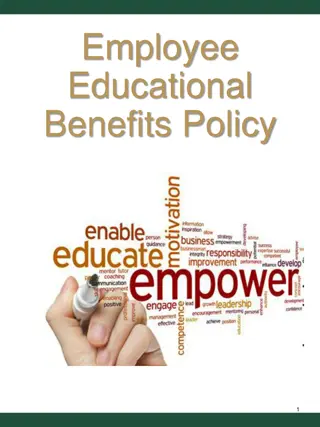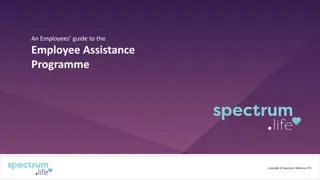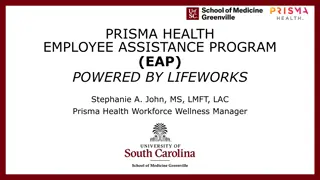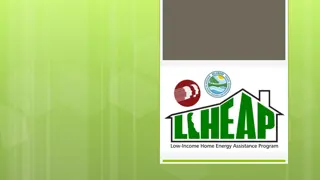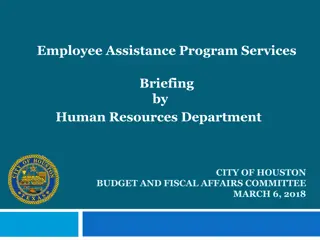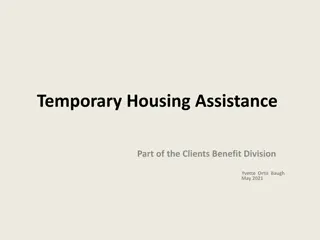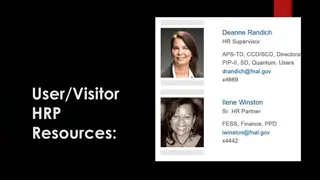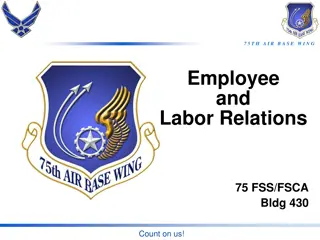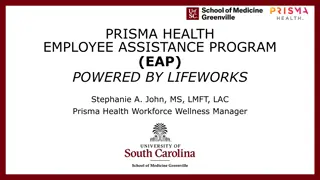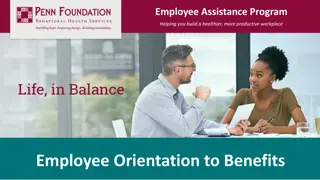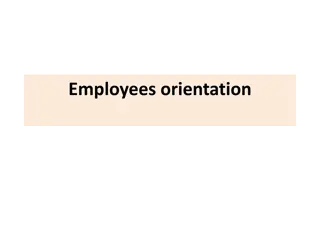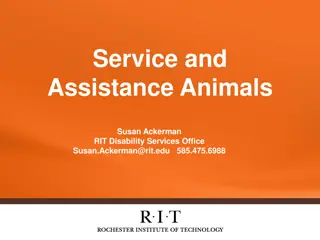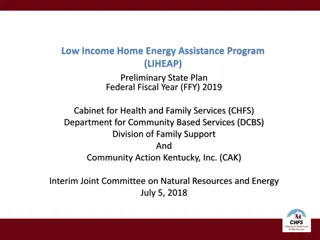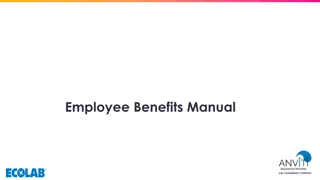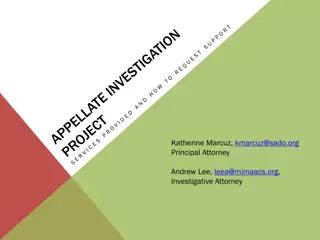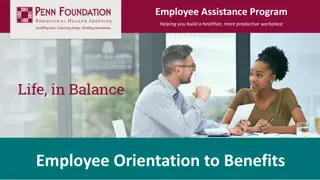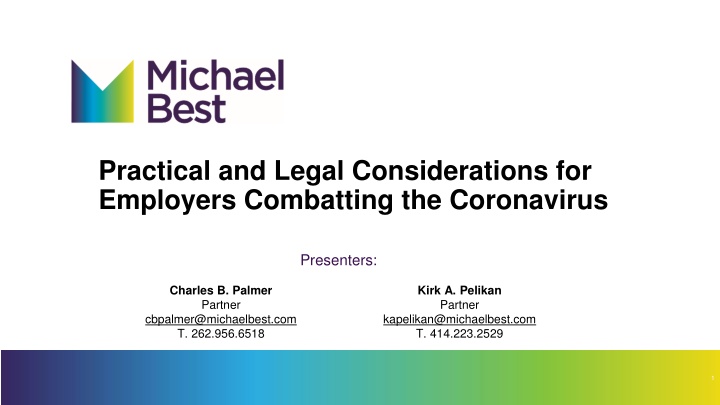
State Employee Assistance Program (SEAP) Overview
SEAP provides assistance to eligible employees, family members, and retirees facing personal challenges that impact their performance at work. The program addresses diverse issues, from drug and alcohol abuse to critical incident stress debriefing, offering confidential support and referrals to relevant services.
Download Presentation

Please find below an Image/Link to download the presentation.
The content on the website is provided AS IS for your information and personal use only. It may not be sold, licensed, or shared on other websites without obtaining consent from the author. If you encounter any issues during the download, it is possible that the publisher has removed the file from their server.
You are allowed to download the files provided on this website for personal or commercial use, subject to the condition that they are used lawfully. All files are the property of their respective owners.
The content on the website is provided AS IS for your information and personal use only. It may not be sold, licensed, or shared on other websites without obtaining consent from the author.
E N D
Presentation Transcript
Practical and Legal Considerations for Employers Combatting the Coronavirus Presenters: Charles B. Palmer Partner cbpalmer@michaelbest.com T. 262.956.6518 Kirk A. Pelikan Partner kapelikan@michaelbest.com T. 414.223.2529 1
ADA Limitations on medical inquiries regarding COVID-19 changed due to pandemic. - Taking an employee s temperature is a Medical Examination under the ADA. Must be job-related and consistent with a business necessity; or Employer must have a reasonable belief that the employee poses a direct threat to health and safety of others that cannot be reasonably eliminated with a reasonable accommodation. Confidentiality restrictions still in place. Can (must) exclude from workplace those with disease and those exposed to disease. - Contacts of contacts not considered exposed. 2
FMLA Can you force an employee to use FMLA leave? - Yes if an employee is on leave for a condition that the employer knows constitutes an FMLA-qualifying condition, the employer may count the leave as FMLA leave. Is COVID-19 an FMLA-qualifying leave? - Maybe it will depend on whether or not the employee is experiencing a serious health condition as defined in the FMLA. Be prepared to go through this analysis. - If new law passes, it will be. What if an employee s child comes down with COVID-19, and the employee stays home to care for him or her is that FMLA-qualifying leave? - See above. The child must have a serious health condition. If an employee calls in sick, claiming to have COVID-19, and you don t believe him or her, can you require a medical exam? - Yes, employers can require a certification from a healthcare provider to support the need for FMLA leave. 3
HR 6201: FMLA Expansion Provides up to 12 weeks of FMLA to employees of employers with fewer than 500 employees for the coronavirus situation. - First two weeks unpaid. - Remainder paid for up to 2/3 of compensation, but in no event more than $200/day or $10,000 in the aggregate. - Employer would claim tax credit for the payment made to employees. Leave is available for: - An employee unable to work or telework because of a need to care for a son or daughter (under 18) where the school or child care provider is unavailable due to the public health emergency. - Employer can require notice. 4
HR 6201: FMLA Expansion Employers with fewer than 50 employees may opt out of this law where compliance would put the company out of business. The Secretary of Labor may order certain health care providers and emergency responders to be excluded from application of this bill, if passed. Health care providers and emergency responder employers may also opt-out. No private cause of action for employees working for an employer with fewer than 50 employees. 5
HR 6201: Emergency Paid Sick Leave Act Applies where the employee is unable to work or telework, due to: - Employee must quarantine (due to public official or medical provider instruction); - Employee is experiencing symptoms and seeking medical diagnosis; - Employee is caring for someone who would otherwise satisfy one of the above; - Employee cannot work because son or daughter s school or care provider is closed or unavailable due to COVID-19; - Employee is experiencing a substantially similar condition specified by HHS, in consultation with Treasury and Labor (unclear what this means) 6
HR 6201: Emergency Paid Sick Leave Act Employer of an employee who is a health care provider or an emergency responder may elect to exclude such employee from eligibility. Duration: - Full-time 80 hours. - Part-time Scheduled hours over two weeks, on average. Amount: Regular rate (2/3 for family care). - Max amount of $511/day for self; $200/day for family care. Notice will issue within 7 days of enactment. Secretary of Labor can exclude health care providers, emergency responders and small businesses from the bill. 7
OSHA Standard Hygiene Practices for Employees Guidance on Preparing Workplaces for COVID-19 (www.OSHA.gov) Promote frequent and thorough hand-washing, including by providing workers, customers, and worksite visitors with a place to wash their hands. If soap and running water are not immediately available, provide alcohol-based hand rubs containing at least 60% alcohol. Encourage workers to stay home if sick Encourage respiratory etiquette (cover coughs and sneezes tissue or elbow) Provide customers and public tissues and trash receptacles. Flexible work (telecommute), work hours (stagger shifts), social distancing (state and local authority) Discourage sharing phones, desks, offices, tools, equipment. Educate on signs of illness and establish procedure to report. 8
OSHA - Standard Housekeeping During Coronavirus OSHA recommends that all employers maintain regular housekeeping practices, including routine cleaning and disinfecting of surfaces, equipment, and other elements of the work environment. Environmental Protection Agency (EPA)-approved disinfectant labels with claims against emerging viral pathogens. https://www.americanchemistry.com/Novel-Coronavirus-Fighting-Products-List.pdf Routinely clean all frequently touched surfaces in the workplace, such as workstations, countertops, and doorknobs. Use the cleaning agents that are usually used in these areas and follow the directions on the label. No additional disinfection beyond routine cleaning is recommended at this time. Provide disposable wipes so that commonly used surfaces (for example, doorknobs, keyboards, remote controls, desks) can be wiped down by employees before each use. 9
OSHA Known Potential Presence of COVID-19 Follow CDC Recommendations found here https://www.cdc.gov/coronavirus/2019- ncov/community/organizations/cleaning-disinfection.html Cleaning staff should wear disposable gloves and gowns for all tasks in the cleaning process, including handling trash. - Gloves and gowns should be compatible with the disinfectant products being used. - Additional PPE might be required based on the cleaning/disinfectant products being used and whether there is a risk of splash (goggles). - Gloves and gowns should be removed carefully to avoid contamination of the wearer and the surrounding area. Be sure to clean hands after removing gloves. Cleaning staff should immediately report breaches in PPE (e.g., tear in gloves) or any potential exposures to their supervisor. Cleaning staff should be trained including providing Safety Data Sheet (SDS) for chemicals and risks of Coronavirus in accordance with OSHA Hazard Communication standard. 10
So Your Employee Has Reported He/She Has COVID-19. How Do You Respond? Must be sent home. (or move away from workers, customers and visitors to room with closed door) But wait, don t forget to get information about other employee exposure. - Within 6 feet for prolonged period - Coughed on. Ask for consent to disclose the fact of their illness to determine other exposure. Do not disclose without consent and only if absolutely necessary. No return to work until 14 days after symptoms have abated It is reasonable to require a doctor s release before return to work. Public health officials should be conducting an investigation Assess risk of other employee exposure based on the CDC guidelines. Exposed - should be instructed to self-quarantine under all circumstances. Symptomatic individuals should be directed to seek medical help. Asymptomatic individuals should remain in self-quarantine for 14 days at home, or as instructed by public health officials.. 11
So Your Employee Has Reported He/She Has Been Exposed to COVID-19. How Do You Respond? Assess risk of other employee exposure based on the CDC guidelines. - Within 6 feet for prolonged period. - Coughed on. Exposed - should be instructed to self-quarantine under all circumstances. Symptomatic individuals should be directed to seek medical help. Asymptomatic individuals should remain in self-quarantine for 14 days at home, or as instructed by public health officials. Do not require doctor notes to return to work after 14 day quarantine if no symptoms. Public health will monitor and health care offices will be extremely busy. If employee later becomes COVID-19 positive, see prior slide. 12
So Your Employee Has Reported He/She Has COVID-19 Symptoms. How Do You Respond? Assess risk of other employee exposure based on the CDC guidelines. - Within 6 feet for prolonged period - Coughed on. Must be sent home. No return to work until 14 days after symptoms have abated. Do not require doctor notes to return to work after 14 day quarantine if no symptoms. Health care offices will be extremely busy. If employee reports as COVID-19 positive, see earlier slide. 13
So Your Employee Has Reported He/She Has Been Exposed to Someone with COVID- 19. Symptoms, but Has No Symptoms. How Do You Respond? Determine if the person with symptoms is being tested for COVID-19. Assess whether employee was actually exposed, based on CDC guidelines - Within 6 feet for prolonged period - Coughed on. If yes to either, assess risk of other employee exposure based on the CDC guidelines, and employee should be sent home and self quarantine for 14 days. 14
And Finally Your Employee Reports Being Exposed to Someone Who Was Exposed Contacts of Asymptomatic People Exposed to COVID-19 CDC does not recommend testing, symptom monitoring or special management for people exposed to asymptomatic people with potential exposures to SARS-CoV-2 (such as in a household), i.e., contacts of contacts; these people are not considered exposed to SARS-CoV-2. https://www.cdc.gov/coronavirus/2019-ncov/php/risk-assessment.html 15
Workers Compensation Should you be worried about worker s compensation claims? Possibly - If your company requires employees to travel, and your employee contracts COVID-19 in the scope of his or her employment, you may be liable for worker s compensation benefits. - If a cluster of employees becomes infected with COVID-19 after working in close contact with another worker who has COVID-19, they could bring claims for worker s compensation benefits and might be able to show a causal link to the workplace. Employers should consider restricting work-related travel to high risk areas, as defined by the CDC. - https://www.cdc.gov/coronavirus/2019-ncov/travelers/index.html 16
What Can Employers do to Protect Employees? Encourage sick workers to stay home and away from the workplace and provide flexible leave policies. Encourage infection control practices in the workplace by sending emails and displaying posters that address and remind workers about proper hand washing, respiratory hygiene, and cough etiquette. https://www.cdc.gov/coronavirus/2019-ncov/downloads/2019-ncov-factsheet.pdf https://www.cdc.gov/coronavirus/2019-ncov/downloads/sick-with-2019-nCoV-fact-sheet.pdf https://www.cdc.gov/coronavirus/2019-ncov/about/share-facts-h.pdf https://www.cdc.gov/coronavirus/2019-ncov/downloads/stop-the-spread-of-germs.pdf Provide written guidance (email, etc.) on COVID-19 appropriate for the language and literacy levels of everyone in the workplace. Employers should work closely with local and state public health officials to ensure they are providing the most appropriate and up-to-date information (e.g., the CDC website). - https://www.cdc.gov/coronavirus/2019-ncov/community/guidance-business-response.html 17
Communication/Education Determine how you will communicate the status of operations to employees if necessary. - Website - Email Designate a point person for answering employee questions related to COVID-19 concerns. Provide up to date information to employees about COVID-19 via email or other written guidance. Encourage infection control practices in the workplace and at home. 18
Michael Best COVID-19 Resources COVID-19 Resource Center: https://www.michaelbest.com/Practices/COVID-19-Resource-Center - Access to all COVID-19 client alerts - View upcoming COVID-19 Webinars - Contact information for Task Force members Subscription options to Michael Best and Michael Best Strategies Alerts - Michael Best Alerts: https://sites-michaelbest.vuturevx.com/5/9/landing- pages/subscription-form.asp?sid=blankform - Michael Best Strategies Alerts: https://www.michaelbeststrategies.com/connect/washington-d-c/#signup 19
Presenters Charles B. Palmer Partner cbpalmer@michaelbest.com T. 262.956.6518 Kirk A. Pelikan Partner kapelikan@michaelbest.com T. 414.223.2529 20

